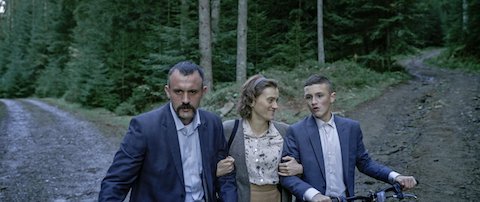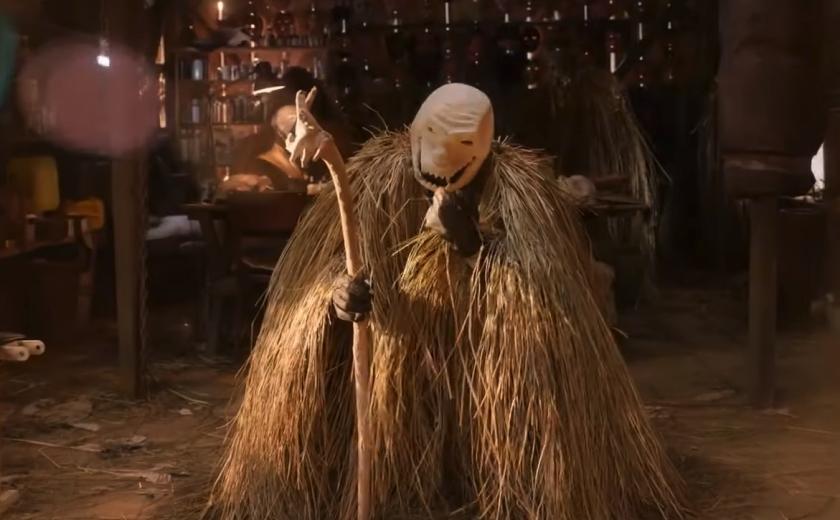It's fair to say that Pamfir, Ukrainian director Dmytro Sukholytkyy-Sobchuk's first feature, has been slightly overtaken by events.
Set in the Carpathian mountains, on Ukraine's border with Romania, and filmed in the days and weeks leading up to the Russian invasion, this stylish movie captures the parochialism of life in the far west of the country, a thousand miles from the war, in a territory called Bukovina that was part of Hungary until World War II. Strangely enough, I watched Pamfir last week only hours after travelling through Bukovina, on the way out of Ukraine, and was struck by the film's lack of topicality in the best sense.
The timelessness of the plot derives from its Homeric structure. A retired smuggler called Leonid (Oleksandr Yatsentyuk) returns home to his poverty-stricken village after months of absence while he's been earning money from a legitimate job in Poland. He is met by his wife Olena (Yelena Khokhlatkina) and brooding teenage son Nazar (Stanislav Potiak) who, along with all the villagers, are preparing for a traditional carnival known as Malanka.
Its demonic masks and costumes mirror the activities of the local evangelical church, which is about as far removed from Ukrainian Orthodoxy as it's possible to imagine. But when Nazar starts a fire in the prayer-room, Leonid (whose nickname is "Pamfir", meaning stone in Ukrainian) is forced back into organised crime to help pay for the damage.
 Carnival costumes lend colour, as well as menace, to the story of a family tragedy. But there are other striking visual components and memorable images like creeping forest mists and luminous terracotta walls.
Carnival costumes lend colour, as well as menace, to the story of a family tragedy. But there are other striking visual components and memorable images like creeping forest mists and luminous terracotta walls.
In fact, the 40-year-old Sukholytkyy-Sobchuk has a gift for symmetrical compositions that are oddly reminiscent of Wes Anderson's. Seen from afar in one continuous steadicam shot, for example, the self-aggrandising Pamfir and his motley crew of smugglers are made by the camerawork to appear ridiculous as they clamber over a mountainous border with backpacks.
At the same time, the almost certainly deliberate outdatedness of this dark fairy tale, with its archetypal themes of good versus evil, seems to highlight the transformation that Ukraine has recently undergone in the eyes of the world. Before 24 February, 2022, this former Soviet republic was usually seen as a poor country in thrall to backwardness and corrupt oligarchs. Its unexpected resilience in the face of Russian aggression has turned Ukraine into an international brand. (Pictured above: Oleksandr Yatsentyuk, Yelena Khokhlatkina, and Stanislav Potiak)
With his buff torso, macho moustache characteristic of Ukrainian men, and resemblance to a wounded but dangerous bear, Yatsentyuk hints at the deep psychological reality of standing up to gangsters. His antagonist, the cowardly but vicious crime boss Mr Oreste, is played by Petro Chychuk as a dead ringer for Vladimir Putin.
In the second half of the movie, which was shown in Cannes last year, Sukholytkyy-Sobchuk abandons his painterly style with its compositionally dense tableaux and circular tracking shots. As the plot hurtles toward a violent resolution at the climax of the carnival, Pamfir begins to feel outdated in a different way. A downward spiral of crime caper clichés take us from Wes Anderson to Guy Ritchie or Quentin Tarantino. A scene in which Oreste's besuited hoods beat up our hero is especially unoriginal and tasteless. Accordingly, the film sinks like a stone - or like a "pamfir".















Add comment